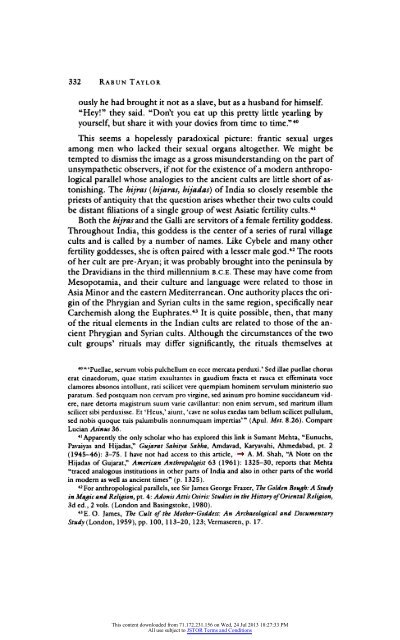Two Pathic Subcultures in Ancient Rome
Two Pathic Subcultures in Ancient Rome
Two Pathic Subcultures in Ancient Rome
Create successful ePaper yourself
Turn your PDF publications into a flip-book with our unique Google optimized e-Paper software.
332 RABUN TAYLOR<br />
ously he had brought it not as a slave, but as a husband for himself.<br />
"Hey!" they said. "Don't you eat up this pretty little yearl<strong>in</strong>g by<br />
yourself, but share it with your dovies from time to time."40<br />
This seems a hopelessly paradoxical picture: frantic sexual urges<br />
among men who lacked their sexual organs altogether. We might be<br />
tempted to dismiss the image as a gross misunderstand<strong>in</strong>g on the part of<br />
unsympathetic observers, if not for the existence of a modern anthropological<br />
parallel whose analogies to the ancient cults are little short of astonish<strong>in</strong>g.<br />
The hijras (hijaras, hijadas) of India so closely resemble the<br />
priests of antiquity that the question arises whether their two cults could<br />
be distant filiations of a s<strong>in</strong>gle group of west Asiatic fertility cults.4'<br />
Both the hijras and the Galli are servitors of a female fertility goddess.<br />
Throughout India, this goddess is the center of a series of rural village<br />
cults and is called by a number of names. Like Cybele and many other<br />
fertility goddesses, she is often paired with a lesser male god.42 The roots<br />
of her cult are pre-Aryan; it was probably brought <strong>in</strong>to the pen<strong>in</strong>sula by<br />
the Dravidians <strong>in</strong> the third millennium B.C.E. These may have come from<br />
Mesopotamia, and their culture and language were related to those <strong>in</strong><br />
Asia M<strong>in</strong>or and the eastern Mediterranean. One authority places the orig<strong>in</strong><br />
of the Phrygian and Syrian cults <strong>in</strong> the same region, specifically near<br />
Carchemish along the Euphrates.43 It is quite possible, then, that many<br />
of the ritual elements <strong>in</strong> the Indian cults are related to those of the ancient<br />
Phrygian and Syrian cults. Although the circumstances of the two<br />
cult groups' rituals may differ significantly, the rituals themselves at<br />
40"'Puellae, servum vobis pulchellum en ecce mercata pcrduxi.' Scd iliac pucllac chorus<br />
crat c<strong>in</strong>acdorum, quae statim exsultantes <strong>in</strong> gaudium fracta et rauca et effem<strong>in</strong>ata voce<br />
clamores absonos <strong>in</strong>tollunt, rati scilicet vere quempiam hom<strong>in</strong>em servulum m<strong>in</strong>isterio suo<br />
paratum. Sed postquam non cervam pro virg<strong>in</strong>e, sed as<strong>in</strong>um pro hom<strong>in</strong>e succidancum vidcre,<br />
nare detorta magistrum suum varie cavillantur: non enim servum, sed maritum illum<br />
scilicct sibi perduxisse. Et 'Heus,' aiunt, 'cave ne solus exedas tam bellum scilicet pullulum,<br />
sed nobis quoquc tuis palumbulis nonnumquam impertias'" (Apul. Met. 8.26). Comparc<br />
Lucian As<strong>in</strong>us 36.<br />
41Apparently the only scholar who has explored this l<strong>in</strong>k is Sumant Mchta, "Eunuchs,<br />
Pavaiyas and Hijadas," Gujarat Sahitya Sabha, Amdavad, Karyavahi, Ahmedabad, pt. 2<br />
(1945-46): 3-75. I have not had access to this article, but A. M. Shah, "A Note on the<br />
Hijadas of Gujarat," American Anthropologist 63 (1961): 1325-30, reports that Mehta<br />
'traced analogous <strong>in</strong>stitutions <strong>in</strong> other parts of India and also <strong>in</strong> other parts of the world<br />
<strong>in</strong> modern as well as ancient times" (p. 1325).<br />
42 For anthropological parallels, sce Sir James Gcorge Frazer, The Golden Bough: A Study<br />
<strong>in</strong> Magic and Rcligion, pt. 4: Adonis Attis Osiris: Studics <strong>in</strong> the History of Oricntal Religion,<br />
3d ed., 2 vols. (London and Bas<strong>in</strong>gstoke, 1980).<br />
43E. 0. James, The Cult of the Mother-Goddess: An Archaeological and Documentary<br />
Study (London, 1959), pp. 100, 113-20, 123; Vermaseren, p. 17.<br />
This content downloaded from 71.172.231.156 on Wed, 24 Jul 2013 18:27:33 PM<br />
All use subject to JSTOR Terms and Conditions
















